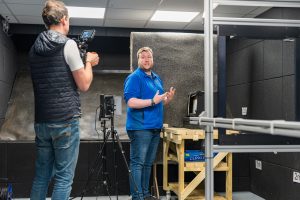
On 9 October 2025, the University of Kent’s state‑of‑the‑art experimental ballistics facility took centre stage in a BBC documentary called Catapult Crime: Killing for Fun. Dr Chris Shepherd, Director of Studies for Chemistry and Forensic Science, used the venue to show that a simple catapult can inflict damage that is both devastating and, in some cases, fatal. The experiment, conducted under full safety protocols, underlines the need for a clearer public conversation about the risks posed by small‑scale projectile weapons.
Experimental Ballistics Facility at the University of Kent
Only a handful of fully equipped ballistics labs exist in the United Kingdom, and Kent’s installation is among the most advanced. Built to the highest modern safety standards, the facility is a hub for students and researchers looking to understand how projectiles behave when they hit various targets. It is used to:
- Analyse bullet ricochets and impact angles;
- Simulate trauma in human analogues;
- Develop better wound‑care techniques for the medical field;
- Assist criminal investigations by reconstructing scenes where uncommon weapons are involved.
Through its rigorous methodology, the lab has produced data that feeds directly back into educational curricula across the School of Natural Sciences, the School of Chemistry, and the School of Forensic Science.
Explore the University of Kent’s Ballistics Research Program here.
Catapult Attacks: What The Data Shows
In the documentary, Dr Shepherd constructed a head replica using bone‑simulating material and silicone‑rubber skin. By firing a 10‑cm stone projectile repeatedly, he recorded fractures and cracks that mirrored the lethal impact patterns seen on human skulls after real catapult strikes. The key findings are:
- Even a moderate‑sized stone can cause comminution fractures, mimicking the severe skull damage seen in real catapult attacks.
- Brain injury can occur due to the shockwave passing through the cranial cavity, a scenario that can result in fatality if left untreated.
- Puncture‑type wounds, similar to those captured in wildlife footage within the programme, can lead to significant blood loss and organ damage.
These results support the increasing call from animal welfare campaigns to restrict the sale and use of catapults on minors. While currently legal, the rising number of documented attacks on both animals and humans has prompted policymakers and the public to reconsider regulatory measures.
Implications for Public Safety and Policy
The research demonstrates that the ‘fun’ aspects of historical projectile weapons can easily translate into serious harm. The data urges authorities to re‑evaluate:
- Existing legal thresholds for what constitutes a weapon;
- Age restrictions for ownership and use;
- Public education campaigns highlighting the risks of unregulated projectile devices;
- Potential support for local communities in mitigating stray projectile incidents.
In response to the study, several local councils have already begun drafting proposals to adjust the legislation that governs the sale and use of small launch devices.
Advancing Forensic Science Through Ballistics Research
One of the standout benefits of Kent’s ballistics lab is its contribution to forensic investigations. By recreating the forces involved in an impact, forensic analysts can:
- Back‑track the trajectory of a projectile given a wound;
- Estimate the distance and velocity required to produce a given injury profile;
- Reconstruct scenes where unconventional weapons are employed, ensuring that evidence is preserved accurately.
These capabilities translate into improved justice outcomes and can even save lives by informing emergency response protocols. Moreover, the laboratory’s work feeds into educational programmes that train future forensic scientists, giving students hands‑on experience with cutting‑edge technology.
How Students Can Get Involved
For students interested in applied sciences, Kent offers undergraduate and postgraduate pathways that integrate ballistics and forensic research. The Undergraduate courses in Chemistry and Forensic Science provide foundational knowledge that can be built upon in advanced seminars and thesis projects. Those looking for a research‑heavy master’s degree can explore the PhD programmes supported by the University’s extensive research funding.
Students gain more than textbook knowledge; they engage directly with experimental setups, data collection, and analysis that have real‑world impact. By working alongside Dr Shepherd and his team, interns and research assistants contribute to studies that shape public policy and safety guidelines.
Consider a Forensic Science degree at Kent here.
Public Engagement and Continuing Innovation
Kent’s commitment to public engagement is evident through its media releases and outreach programmes. By inviting the public to view research findings via BBC documentaries, the university bridges the gap between academia and everyday life. Future projects aim to investigate the effects of other historical weapons—such as catapults, bows and arrows, and hand‑throwing stones—on modern safety standards.
Take the Next Step in Science and Safety
The research showcased in the BBC documentary is just one example of how rigorous scientific inquiry can inform policy, improve forensic science, and ultimately protect communities. Whether you are a budding scientist, a policy maker looking for evidence‑based guidance, or a concerned parent, the data underscores the importance of regulated access to projectile devices.
Interested in building a career where science meets public service? The University of Kent offers pathways that combine rigorous academic training with real‑world impact.
Apply for Undergraduate Studies at Kent today here and start contributing to research that matters.
We welcome your thoughts—share your perspective in the comments below or reach out through our contact form to discuss how you can join us.

